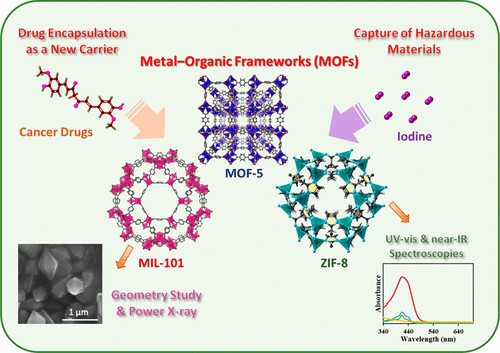Analysis of Metal-Organic Frameworks
Metal-organic framework (MOF) is a relatively new type of porous materials, which shows great potential in various applications such as gas separation, catalysis, storage and so on. In particular, the large pore size, the variability of pore size and the possibility of synthesis make them generally superior to other porous materials, such as zeolite. The metal-organic framework is composed of metal centers or metal clusters connected by organic ligands. The variability of metal and organic connector types leads to a wide variety of MOFs with selected characteristics.
 Figure 1. Metal-organic framework (MOF). (Sakamaki et al., 2020)
Figure 1. Metal-organic framework (MOF). (Sakamaki et al., 2020)
Solid state NMR is of great significance for MOF characterization. Creative Biostructure can provide a variety of information about materials, from ligand or metal center characterization, ligand kinetics, residual solvent molecules to adsorbed substances.
Object of Characterization
In MOF, the objects we can represent include but are not limited to:
- Adsorption of water
- Adsorption of carbon dioxide
- 2H containing molecules
- Adsorption of metal precursors
- Other small molecule adsorptions
Information Available from MOF
NMR is very suitable for studying the adsorption of small molecules in porous systems. We can obtain multiple pieces of information for customers through NMR, including:
We specifically observe guest molecules in an appropriate arrangement, such as isotope labeling or using molecules containing NMR nuclei that do not exist in the host structure.
We can determine molecular dynamics and the mobility of guest molecules in pores for customers. This is usually done through temperature-related linear analysis and relaxation measurement.
We can obtain information about the adsorption state generated by isotropic chemical shifts for customers, such as the reaction with some adsorption sites in the host structure. The difference in chemical shift between the molecule without MOF usually indicates chemical adsorption. There is physical adsorption without displacement change.
The host-guest interaction can also be characterized by the dipole-dipole interaction and the distance between the nucleus of the host frame and the nucleus of the guest molecule. Here, it is usually necessary to select the appropriate core combination that gives clear results. Our experiment may have to be carried out at a lower temperature, because molecular dynamics will also affect the size of the dipole-dipole interaction.
If the guest molecules cannot be directly studied or the measurement is very complicated, we can still obtain information about adsorption by changing the nuclear degree shift of the host structure.
Characterization of Water Adsorption in MOF
The information we can obtain from the study of water adsorption by 1H NMR and 13C spectroscopy includes:
- Adsorption process
- Hydrodynamics
- Hydration of MOF
- Adsorption sites of water molecules
- Decomposition mechanism of MOF framework
Because ligands usually contain hydrogen atoms, the resolution needs to be high enough to distinguish a single signal. In order to simplify the separation of proton signal from main structure and water, we will also use 2H2O. Or synthesize a deuterization framework, which only has 1H signal from water molecule.
When the 1H resolution is not enough, we will also indirectly study water adsorption through metal atomic spectroscopy (such as 25Mg or 27Al).
Characterization of Metal Precursors Adsorption in MOF
Through NMR characterization of MOF doped with metal precursors, we can obtain information including:
- Demonstrate the combination of polyoxometalate (POM) and MOF.
- Chemical shift analysis and comparison service position of POM with and without MOF.
- Demonstrate the combination of metallocene and MOF.
Creative Biostructure is committed to providing high-quality NMR analysis services to advance the life sciences fields. If you have any questions or needs, please contact us and our customer service staff will help you the first time.
Ordering Process
Reference
- Sakamaki Y, et al. Preparation and applications of Metal–Organic Frameworks (MOFs): a laboratory activity and demonstration for high school and/or undergraduate students. Journal of Chemical Education. 2020, 97(4): 1109-1116.

